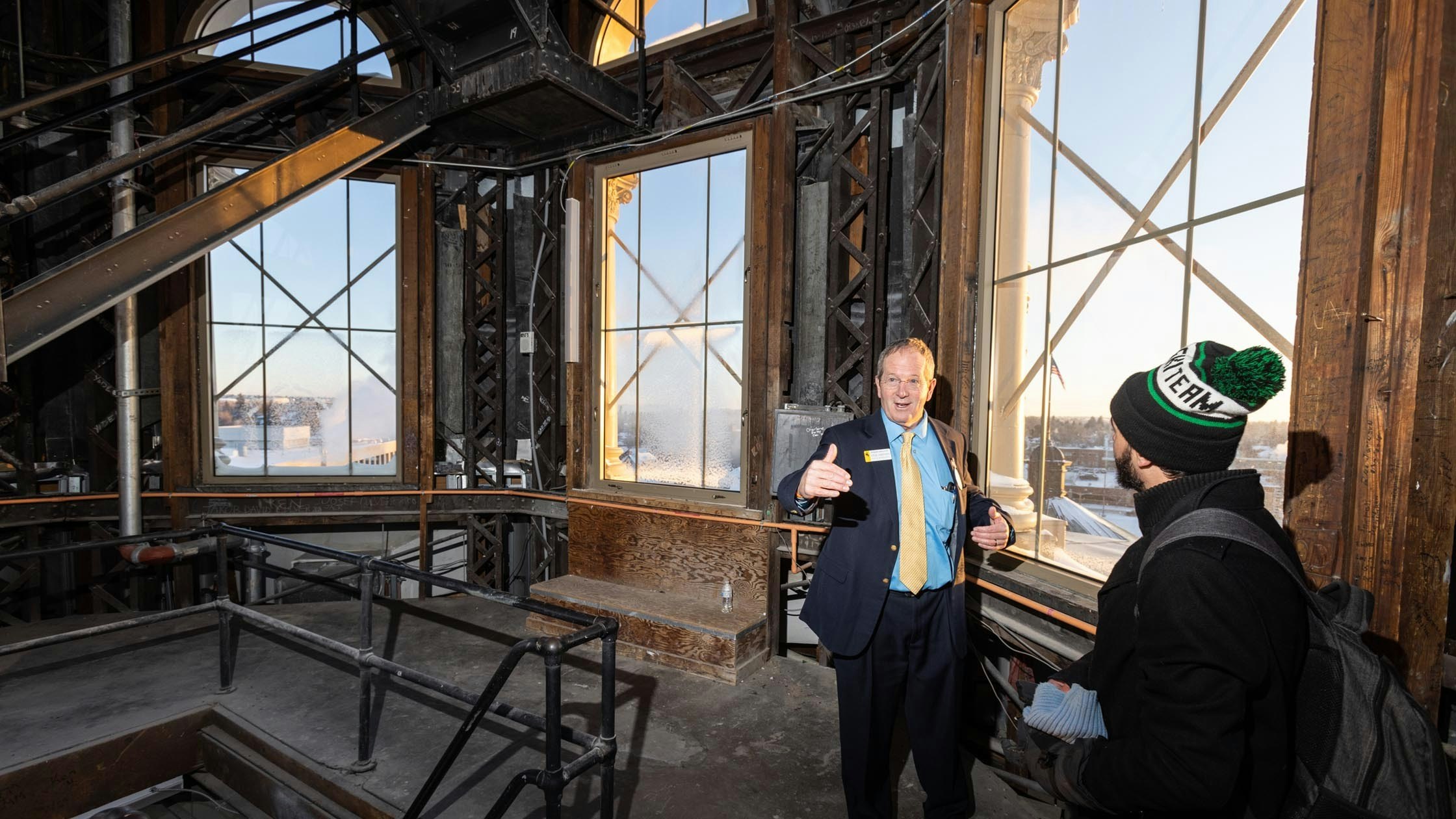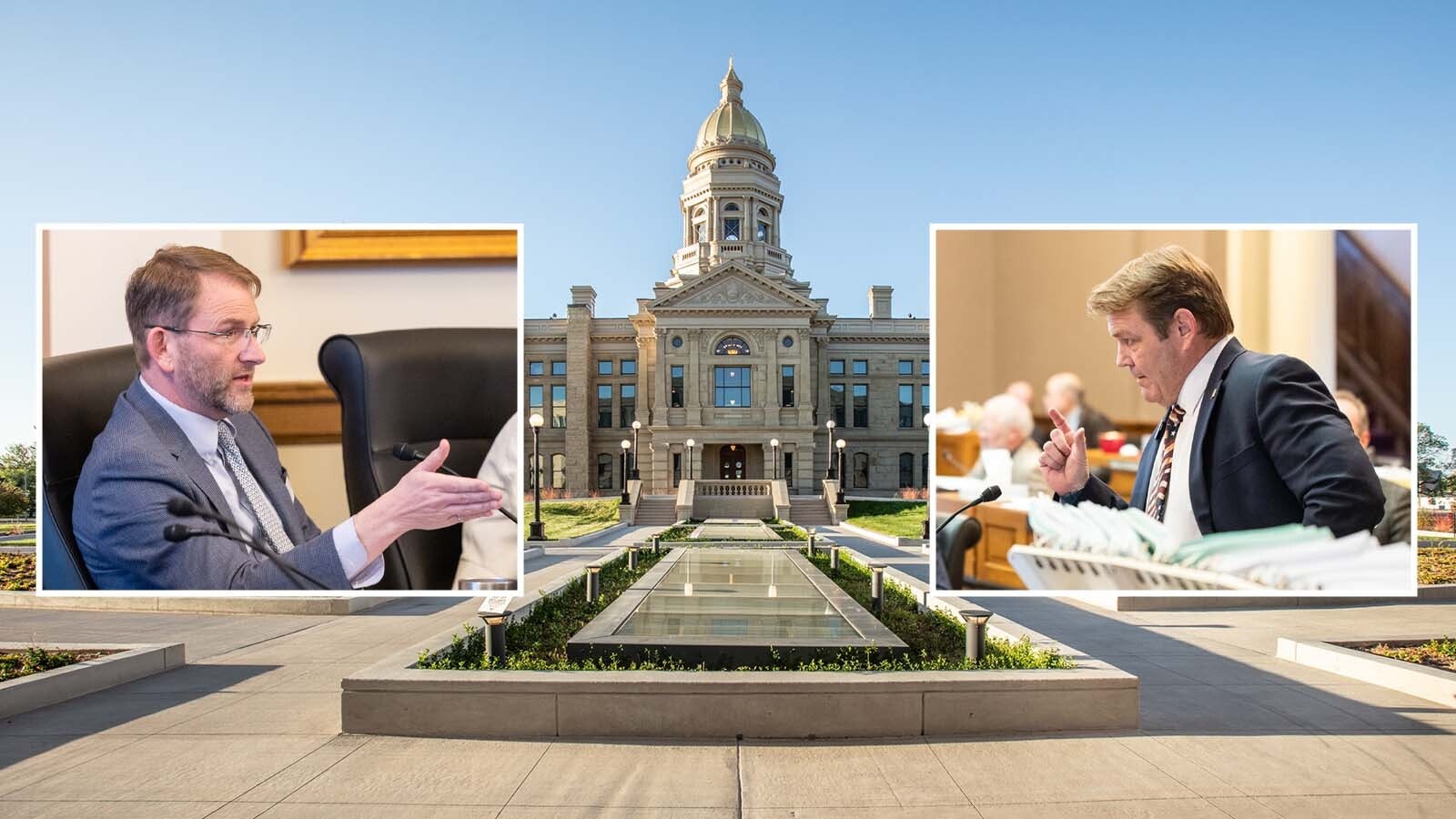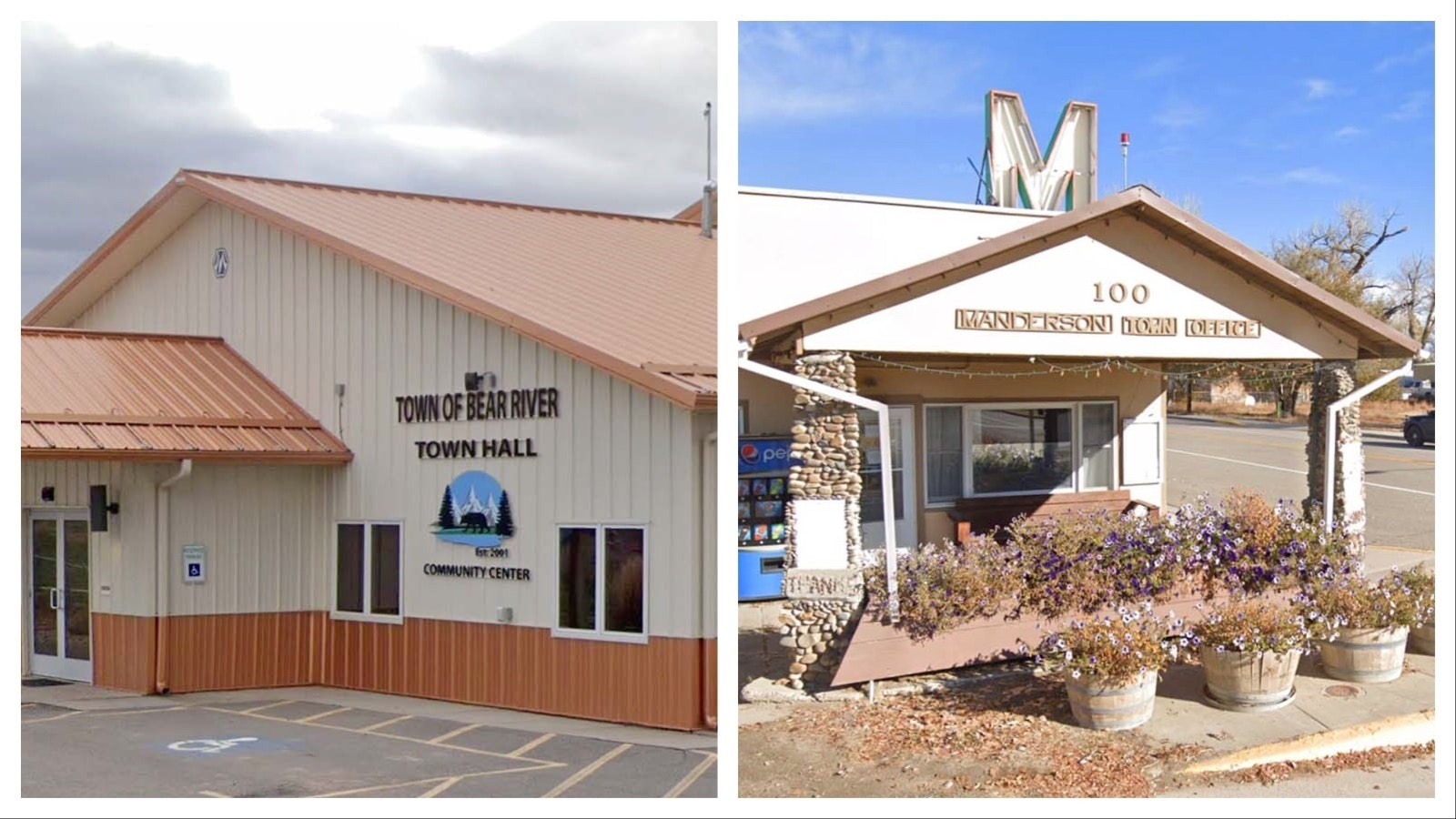Few are as familiar with the halls of the Wyoming Capitol as state Rep. Steve Harshman, R-Casper, a 20-year veteran of the Wyoming Legislature.
Harshman often gives tours of the Capitol building, highlighted by a trip up to the Capitol’s dome. What the Capitol represents to Harshman and many others is the history of a state he has always called home. Many memories from his time in the Legislature are scattered throughout the building.
“It’s our history,” Harshman said. “It’s a time machine.”
A Time Machine
Walking up to the dome in some ways feels like going up to a barn attic, maneuvering up tight staircases and narrow corridors to get to the top floor.
On a chilly morning last week, Harshman showed off the 360-degree panoramic view from the inside of the Capitol’s golden dome, baked in the soft glow of an early morning sunrise. The light from this space splashes down through stained glass and onto the Capitol rotunda below in a collage of bright colors.
Unlike many other state capitols made of stone, the interior construction of the Wyoming dome almost entirely consists of wood. Harshman said Wyoming is one of only 10 states to have a gold exterior dome. The dome isn’t made up of pure gold slabs of course, but rather, copper gilded in gold leaf. A metal scaffolding frame reinforces the wood on its exterior.
Stretching around the dome is a line of circular windows, making the viewer feel almost like a mouse staring out from the inside of a block of Swiss cheese. Looking out at the steam and smoke wafting off of buildings far below, a small smile stretched across Harshman’s face.
The second tallest building in Cheyenne, one can see for many miles from the dome. When the building was finished in 1890, there were virtually no trees anywhere in the area.


Harshman referenced an 1887 letter written by construction worker John Feick to his bride back in Ohio.
“He says, ‘you’ll love it out here,’” Harshman recounted. “He says, ‘you can go out in any direction and see 100 miles and see nothing but deer, prairie dogs and wolves.’”
Also dotting the inside of the dome are countless signatures left by visitors to the dome, some of which are more than 100 years old. Some of them are carved into the wood while most others are written in pen. A more recent signature was left by Baggs Republican Senator Larry Hicks.
Harshman said he has a special affinity for Capitol buildings and always tries to visit another one when he goes on vacation. He’s been to North Dakota, Utah, South Dakota, Idaho, Arizona, Texas and Oregon’s capitols to name a few, but Wyoming, of course, is his favorite.
Harshman said when the light hits the stained glass windows behind the Speaker’s chair just right towards the end of the day, it looks like it’s on fire.
Harshman served two consecutive terms as Speaker of the House from 2017-2020 and is also the longest currently serving member of this body. He was Speaker of the House during the last two years of a Capitol restoration project that lasted from 2014-2019. Many of the current features visible in the Capitol today are a result of this project.
History In the Walls
Built over the course of four years from 1886-1890, the building’s initial construction predated Wyoming statehood. Another important addition took place in 1917. With each expansion,the state’s legislative chambers also grew.
Harshman said a lot of the original materials were recycled for each expansion, including original bricks still located inside the building.
“That’s pretty cool,” he said.
A hallway is now located where the 1917 expansion had previously created a balcony to look down at the House chamber.
Previously, the House chamber was surrounded by balconies on all four sides, but the eastern balcony was removed to allow for an expansion as a result of the Legislature adding more members.
There are many relics from the Capitol’s early years still visible to the naked eye at the Capitol, but without prior knowledge, one could never know the historical significance of these artifacts.


Historic Supreme Court Chambers
Take for instance the Historic Supreme Court chambers, which at one time hosted not only the court, but also Wyoming’s territorial government before becoming a state. In 1889, the Wyoming Constitutional Convention met in the chambers and reaffirmed the right for women to vote. This is a major reason behind why the Capitol was designated a U.S. National Historic Landmark in 1987, to recognize Wyoming being the first state to grant women suffrage in a state constitution.
The space also served as the Wyoming Supreme Court’s chamber and later housed the Legislative Service Office.
The original configuration of the room with a two-story ceiling and second-floor gallery was lost in the 1974-1980 Capitol renovation when the Chamber was divided into two distinct floors, according to the Wyoming Capitol Square Project. Harshman said an unknown layer of paint was rediscovered during the restoration project, which led to the room being restored to its original design.
“Nobody knew all this was in there,” he said.
The golden-hued 1888 decorative trompe l’oeil pattern was returned to the walls, sitting on a solid light blue background.
A chandelier that had been in the original Supreme Court chambers but was moved to a different room in the 1970s was returned to its former glory with the restoration.
“Thank goodness they never threw it away,” Harshman said. “They threw so much stuff away but luckily they never threw that away.”
New carpet was installed to match the original 19th century carpeting as closely as possible.


Hidden Treasures
During the restoration process, many hidden gems from the building’s original construction were re-discovered, such as original paint, coffered ceilings, ornate columns, arched doorways, tall windows, decorative door knobs and woodwork. Pieces of old opera posters were also found underneath old wood subfloor planks.
There were paintings located on six vaults located in the basement of the Capitol that were also restored. The outside of each vault displays a scene of lush wooded nature.
“It’s history, little kids love this stuff,” Harshman said.
Harshman said in many ways the project was more emblematic of bringing the Capitol back to its original form rather than creating something new.
“The best part is we kind of restored it, restored it to the way it used to be,” he said. “It’s not a bunch of fluorescent tubes and lime green paint.”
He said most of the changes made to the Capitol over the years came in a fairly innocuous manner, such as staff members wanting to add a wall to make a new office or lay on a fresh coat of paint. Now, even small changes like these need to be approved by a committee.
One feature Harshman does miss is the intimate nature offered by some of the old committee rooms which often led to legislators directly facing each other as they worked on bills, with the public watching in very close proximity.
In their place are six meeting rooms added as part of the Capital Extension aspect of the project.
There are around 600 wood spindles located on different staircases throughout the Capitol building. On the staircase leading to the House chambers, one spindle was deliberately placed upside down by Amish carpenters to symbolize that only God can be perfect.
“I walk up the stairs every morning, give that baby a double tap,” Harshman said with a chuckle.
In the waiting room outside the House chambers, there are two separate posters up from the 1913 Legislature. Harshman said the Republican and Democrat parties were so mad at each other at this time that they refused to have their photos together in the same portrait. That year, a brawl had broken out on the floor of the chamber and a photo was smashed over one legislator’s head. That photo was the portrait of the 1913 Democratic State House legislators, still showing a crack to this day.
There were also four new bronze sculptures added that now stand in the four corners of the Capitol rotunda. “The Four Sisters” represent the values of truth, justice, courage and hope.
Product Of The Building
Harshman takes great pride in what became the finished restoration product and pointed out that all the work was paid with cash, on time and on budget for a total cost of around $300 million. He said there had been some pushback at the time to draw the project out over a longer period of time but he put his foot down.
“I was insistent that we finish this,” he said.
About half the cost of the restoration project went to a feature no one can see, but benefits all who enter the Capitol. This was the addition of foundational supports about 35 feet below the Capitol.
Harshman showed off another small room that used to house Appropriations Committee meetings.
“That’s really where I got my start up in my first couple of terms,” he said. “I’d spent 10 years in Appropriations and I chaired Appropriations.”
Portraits of former Wyoming governors can also be found on the walls of the Capitol. Harshman fondly looked up at one of former Gov. Stanley Hathaway.
Hathaway holds a piece of special admiration for Harshman, the namesake of Wyoming’s Hathaway Scholarship, which was created in a bill brought by the Casper legislator. Hathaway was adopted and grew up in Wyoming. He later flew 50 missions in World War II.
Upon returning home, Hathaway became a prosecuting attorney in Goshen County and then governor in 1966. Hathaway helped rescue the state out of dire financial straits by sparking coal production and other economic initiatives. He also championed the enactment of Wyoming’s first mineral severance tax in 1969 and the creation of the Permanent Mineral Trust Fund in 1974.
“It was pretty amazing,” Harshman said.
Harshman finished the tour succinctly, expected to chair a morning committee meeting.
He wouldn’t take much credit for the restoration project, seeing the work as simply fulfilling his fiscal and professional obligation to the building he holds so dear.
“One-hundred and twenty years from now, somebody else is going to have to do it,” he said. “We did our part, paid cash and did it the right way and then it’ll be here for the next generations to come. That’s the beauty of it.”





